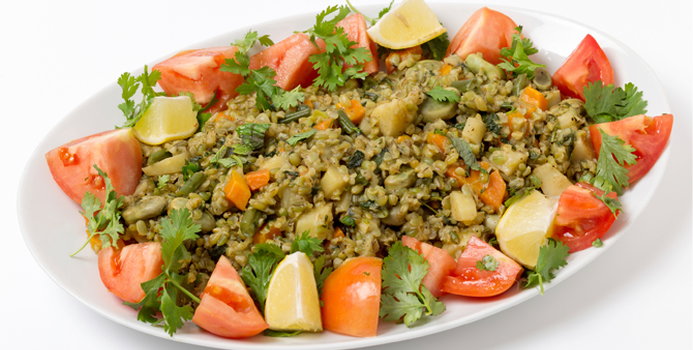Freekeh, an ancient grain that is getting more popular by the minute, is quickly making its way onto plates across the world. Freekeh, which is pronounced as "freek-uh", is an Arabic word meaning "to rub", alluding to way it is made. The wheat is harvested while it is young, is then parched and roasted, and the outer charred part is rubbed off.
History
Believe it or not, the discovery of freekeh resulted from a freakin' awesome accident a couple thousand years back in the Middle East when a village was attacked and their young green wheat crop was set on fire. Determined not to lose all of their crop, the villagers rubbed off the charred outside of the wheat and found that the inside was not spoiled after all, and it was quite delicious!
How Does It Taste?
Freekeh's flavor and texture has been described as nutty, slightly smoky, and chewy.
Nutrition
Freekeh usually comes from wheat and has been found to be high in hunger-squelching fiber and muscle-building protein. Freekeh is also high in iron, which helps ward off fatigue and keeps the cells in your hair, nails, and skin healthy. Additionally, freekeh is a good source of magnesium, vitamin B6 and niacin.
Because freekeh is made from wheat, it contains gluten and is not suitable for people with celiac disease.
Freaky Fast Freekeh
If I haven't already convinced you to give freekeh a try, an added bonus is that it only takes about 20 minutes to cook, which is quite convenient compared to brown rice, which takes upwards of 45 minutes to cook.
Freekeh's Versatility
You can use freekeh just as you would any of your other favorite grains.
- Toss it into your favorite soups or stews for a well-balanced, one-pot meal.
- Mix some cooked freekeh into your homemade veggie burgers for an exciting new flavor profile.
- Perk up your usual pilaf using freekeh in place of rice, cooking it up with some onion, garlic, chicken broth, olive oil and your favorite herbs and spices. It can be served hot or cold.
- Spruce up your scrumptious salads by adding some cooked freekeh to your leafy greens.
- Banish boring breakfasts by fixing up some warm freekeh in place of typical oatmeal. Dial up the flavor by cooking the freekeh in almond milk instead of water, and add in some cinnamon and vanilla extract.
Basic Cooking Instructions
To whip up a basic batch of freekeh, which can then be used across many delicious, healthy recipes, simply place 1 cup of dry freekeh in a medium-sized pot and toast it for about 3-4 minutes or until it becomes fragrant (this will enhance its nutty flavor). Then, add in 2.5 cups of water and bring it up to a boil. Cover the pot, turn the heat down to simmer and continue cooking it until all of the liquid has been absorbed -- about 20 minutes should yield 4 tender cups of fabulous freekeh.
Okay, it's been established that freekeh is awesome. So where can you buy it? Seek out freekeh in the same grocery store aisle as other grains, such as rice, quinoa and bulgur. If your local store doesn't carry freekeh, ask the store manager to start carrying it. In the meantime, you can search for freekeh at specialty food stores or purchase it online.

Kari Hartel, RD, LD is a Registered, Licensed Dietitian and freelance writer based out of St. Louis, MO. Kari is passionate about nutrition education and the prevention of chronic disease through a healthy diet and active lifestyle. Kari holds a Bachelor of Science in Dietetics from Southeast Missouri State University and is committed to helping people lead healthy lives. She completed a yearlong dietetic internship at OSF St. Francis Medical Center in Peoria, IL, where she worked with a multitude of clients and patients with complicated diagnoses. She planned, marketed, and implemented nutrition education programs and cooking demonstrations for the general public as well as for special populations, including patients with cancer, heart disease, diabetes, Alzheimer's disease, obesity, and school-aged children.



